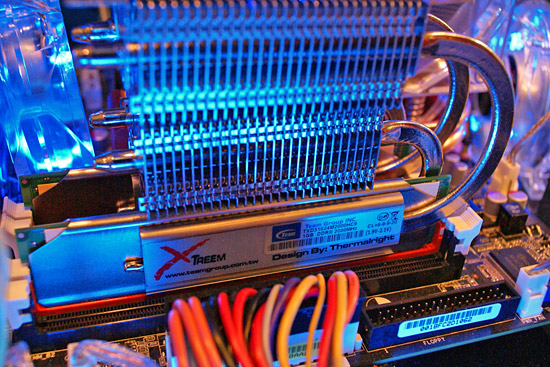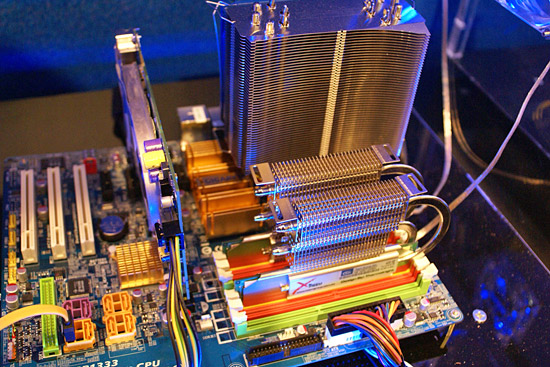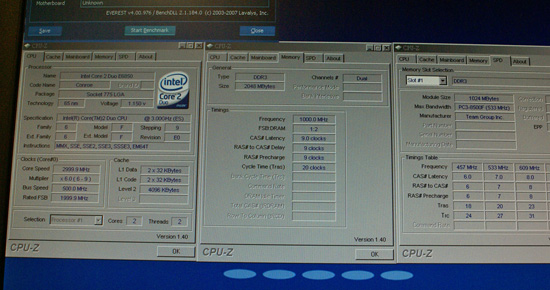Computex 2007: AMD's Barcelona and Other Products
by Gary Key on June 11, 2007 4:00 AM EST- Posted in
- Trade Shows
More Show Coverage
Besides our time spent with Barcelona, we decided to take the last day of Computex and take a last walk around the various halls looking for products or demonstrations that impressed us over the course of the last week in Taiwan. We've got some additional Computex coverage including a few interesting demonstrations behind closed doors, but first we need to catch a flight back home.
In terms of performance or excitement, we have to say that this year's show was again dominated by Intel based products. This is not to slight AMD, but the green team really did not bring its upcoming firepower to the show. This is not because they did not want to, but as we discussed already Barcelona/Agena as well as RD790 are just not mature enough yet to make the same kind of splash that Core 2 Duo did for Intel last year - and that early Penryn/X38 previews are doing to a lesser degree this year.
It would take several hundred pages of coverage to provide details on all of the products on display at this year's Computex. The vast majority of products we witnessed, touched, or tested have already been announced or even released so this year's show was a bit anti-climatic. Still, let's take a quick look at a few products that impressed us before we finish up our coverage and return home.
Team Group
Team Group is a well-known manufacturer of high performance memory and they had several demonstrations at their booth but we found these two to be extremely interesting.

The new Team Xtreme TXD3102-4M2000HC9 is a 1GB DDR3 module rated at 2000MHz. The modules are cooled by a custom Thermalright heatspreader and feature 9-9-9-20 timings at 1.90V~2.1V. This voltage is quite high for DDR3 memory but the modules feature Micron's new 8x128 ICs on a proprietary board design. While there has been plenty of screenshots showing DDR3 memory running above 2000MHz, those have generally been completed with a single module or custom 512MB modules in dual channel mode. In contrast, Team has managed to qualify this 2GB memory kit on the ASUS P5K3-Deluxe in dual channel mode up to 2100MHz.


Team Group also had their new TXDD1024M1333HC5, which is a 1GB DDR2 module rated at 1333MHz (on P35) with 5-6-6-18 timings at 2.35V~2.45V. This memory was installed on a Gigabyte GA-P35C-DS3R board with voltage set to 2.40, E6600 running at 6x400FSB, and the memory set at a 3:5 ratio with the timings listed above. While impressive for DDR2, we will have to wait to test the memory ourselves as chipset and memory strap latencies are fairly reduced on the Gigabyte board at this FSB setting.
Besides our time spent with Barcelona, we decided to take the last day of Computex and take a last walk around the various halls looking for products or demonstrations that impressed us over the course of the last week in Taiwan. We've got some additional Computex coverage including a few interesting demonstrations behind closed doors, but first we need to catch a flight back home.
In terms of performance or excitement, we have to say that this year's show was again dominated by Intel based products. This is not to slight AMD, but the green team really did not bring its upcoming firepower to the show. This is not because they did not want to, but as we discussed already Barcelona/Agena as well as RD790 are just not mature enough yet to make the same kind of splash that Core 2 Duo did for Intel last year - and that early Penryn/X38 previews are doing to a lesser degree this year.
It would take several hundred pages of coverage to provide details on all of the products on display at this year's Computex. The vast majority of products we witnessed, touched, or tested have already been announced or even released so this year's show was a bit anti-climatic. Still, let's take a quick look at a few products that impressed us before we finish up our coverage and return home.
Team Group
Team Group is a well-known manufacturer of high performance memory and they had several demonstrations at their booth but we found these two to be extremely interesting.

 |
| Click to enlarge |
The new Team Xtreme TXD3102-4M2000HC9 is a 1GB DDR3 module rated at 2000MHz. The modules are cooled by a custom Thermalright heatspreader and feature 9-9-9-20 timings at 1.90V~2.1V. This voltage is quite high for DDR3 memory but the modules feature Micron's new 8x128 ICs on a proprietary board design. While there has been plenty of screenshots showing DDR3 memory running above 2000MHz, those have generally been completed with a single module or custom 512MB modules in dual channel mode. In contrast, Team has managed to qualify this 2GB memory kit on the ASUS P5K3-Deluxe in dual channel mode up to 2100MHz.


Team Group also had their new TXDD1024M1333HC5, which is a 1GB DDR2 module rated at 1333MHz (on P35) with 5-6-6-18 timings at 2.35V~2.45V. This memory was installed on a Gigabyte GA-P35C-DS3R board with voltage set to 2.40, E6600 running at 6x400FSB, and the memory set at a 3:5 ratio with the timings listed above. While impressive for DDR2, we will have to wait to test the memory ourselves as chipset and memory strap latencies are fairly reduced on the Gigabyte board at this FSB setting.










64 Comments
View All Comments
TA152H - Monday, June 11, 2007 - link
And if they had, they would have probably gone with the memory disambiguation of the Core 2, instead of the non-speculative load reordering of the Pentium Pro to III. They may not have realized when they were making it Intel was going to raise the bar.Either way, it's impossible.
Regs - Monday, June 11, 2007 - link
Sure..maybe they just decided to pick up a plan that was considered dead and go through with it. It was all ready reported they were trying to re-spin the K8 before the Core Duo was ever announced though it was cancelled because it was dependent on highly-threaded applications that are simply not coming any time soon.TA152H - Monday, June 11, 2007 - link
That's a different processor design that they killed. But, you bring up a huge misconception that most non-programmers have, that with more work you can get really great performance out of threading. All you have to do is put in the time and rethink how to code. It's utter nonsense, and there is something called Amdahl's Law that is worth reading for people that don't understand or believe this.Some algorithms will work well with threading, many, many will not. So, yes, AMD killed that dog and luckily so. If they came out with that, I'd be really, really worried for the company.
But this new processor isn't anything particulary risky or scary. It's a very nice upgrade in many areas, and considering the K8 is obsolete, but not horrible like the P7, it should turn out to be a fine processor and at the minimum competitive for a while.
6-12 months is absolutely incorrect. If you're saying that because you believe it, you need to do a little more research on this type of thing because it's entirely implausible. If you're saying it because you're frustrated with AMD and just lashing out, I can understand that completely. But, try to keep it in perspective; it's still a good processor but it just has a few problems before it's release.
Regs - Monday, June 11, 2007 - link
Highly frustrated. If this was a long planned project then their execution is well, I guess we have to see. Like the bias before the Opteron launched I guess we should not make the same mistake twice.TA152H - Monday, June 11, 2007 - link
While I can understand your frustration, try to keep a few things in common.This is pre-release silicon, of course, and that might not seem like such an important thing, but keep in mind that EVERY processor on that core has to run at the designated speed. So, if one can run at 2.8 GHz, one at 2.6 GHz, another at 2.3 GHz, and one at 1.8 GHz, you're stuck at 1.8 GHz for the entire part. The margin for error is so small because of native quad core decision, it's not surprising the numbers are so low considering the stage of development it's in. At this point, the manufacturing is still fairly new, the processor is of course very new, and with the low margin for error it's going to look bad. But, AMD is a weird bird, they seem to come out with terrible processors on the first version of a new lithography, and continue to improve it quite a bit, much moreso than Intel does. This and getting less scatter with regards to maximum frequency should allow the Barcelona to improve pretty quickly through the iterative improvements AMD does with their manufacturing.
I can understand why you'd be frustrated, but I think it's early to give up on them compeletely. I think most of it is the sting of going native quad-core right off the bat with a brand new processor architecture. It's a lot to deal with in one shot, especially with a fairly new manufacturing process. They probably should have done one thing at a time, but sooner or later they'll get it right. I don't think it will be too late for it to matter either, but who knows?
Regs - Monday, June 11, 2007 - link
Yes trust me I read a lot of articles about the "Bark". From its symmetric ALU's, down to the non-speculative memory access reordering.I'm not giving up on AMD at all but it's a ton of fun seeing too CPU manufactures diverge. Just like how you talk about how badly your team is doing mid-season, it some how enlightens your hope for them during the post-season.
TA152H - Tuesday, June 12, 2007 - link
Go Yankees?TowerShield - Monday, June 11, 2007 - link
I was figuring the product might have died after it didn't show up in May.Gary Key - Monday, June 11, 2007 - link
It worked beautifully under XP Pro with my laptop, Vista compatibility still needs some fine tuning before the unit is launched. ASUS is intent on completing the project within the next four to six weeks.poisondeathray - Monday, June 11, 2007 - link
Is the XG Station still designed with the Express Card interface (480Mbit or 2.5Gbit depending on USB or PCI Express)?What impact on high resolution gaming does this limited interface bandwith present?